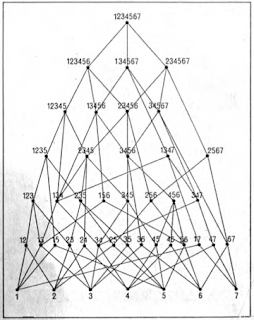(I apologise for the long-winded review, but the reading incorporates a lot of important ideas that will probably form the basis of the entire project).
As outlined by Cameron in the theme group selection page, the reading "A city is not a tree" by Christopher Alexander (accessible here) will be the basis for the theme group topic and thought process for tutorial group 'Distributed 2'. Below is an outline of the points discussed in the article; beginning with an introduction into the terminology and how it applies to the issues at hand within the Australian capital.
The article discusses the structure of cities; primarily natural and artificial (planned) city. Not only is the reading quite informative in general about the structure of traditional and modern day cities, but it also has particular relevance to the planned nature of Canberra. It seems that a semi-lattice structure is what is missing from Canberra.
The semi-lattice structure. Note the overlapping elements.
Alexander frames some important questions on the evolution of modern cities, and how they are reaching a point of crisis, and that it is important to understand the basic underlying structure of cities to ensure their positive development in the future. It was recognised that "the city is a system of vast complexity and in turn is part of a bigger system of social organisation whose values and goals are being questioned" (pg. 1).
The two terms used in the paper are that of a 'tree structure' and a 'semi-lattice structure'. Both of these terms are used in relation to a way if thinking about how "many small systems go to 'make up a large and complex system.'" They are names for a structure of sets; that is - a structure of a collection of element we believe / see as belonging together. When elements within these sets are believed to belong together and work together, we refer to the set of the elements as a system.
When these structures meet certain conditions they are referred to as a semi-lattice. If the structure meets more restrictive conditions, it it referred to as a tree.
Definitions;
Semi-Lattice; "A collection of sets forms a semi-lattice if and only if, when two overlapping sets belong to the collection, then the set of the elements common to both also belongs to the collection" (pg. 4).
Tree; "A collection of sets forms a tree if, and only if, for any two sets that belong to the collection, either one is wholly contained in the other, or else they are wholly disjoint" (pg. 5).
The top image is a typical tree structure. The bottom image is a semi-lattice structure.
The main difference between the two systems is that a semi-lattice contains overlapping units; making it a much more complex and stable structure than a tree.
Alexander continues to discuss how modern day architects, planners, engineers, etc. thinking only in terms of 'tree structures' (as semi-lattice structures are too difficult to visualise within ones mind), and this is what is "crippling our conceptions of the city". The lack of structural complexity is providing only an artificial solution to issues within our cities. Tree structures lack connection to other elements within the structure, hence failing as a structural system.
Examples;
Alexander provides a few examples of cities designed as trees, and discusses the issues found within this.
The image below is of Brasilia, in which "the entire form pivots about the central axis, and each of the two halves is served by a simple main artery. This main artery is in turn fed by subsidiary arteries parallel to it. Finally, these are fed by the roads which surround the super-sized blocks themselves. The structure is a tree". This was one of the cities I analysed earlier in the semester, so this is an interesting comparison.
Looking through the examples of tree like cities, I was able to identify some points that are similar to the issues faced within Canberra;
- The city is divided into separated / segregated units; in Canberra there is a segregation of the university, CBD, cultural, parliamentary, military and historical precincts. In a semi-lattice structure these elements should overlap.
This is shown diagrammatically below;
The structural diagram of this would look similar to the one below (which is for a different city, but one with a similar issue). As you can see, it is a tree structure.
Alexander relates the common creation of tree structures to the "compulsive desire for neatness and order that insists that the candlesticks on a mantelpiece be perfectly straight and perfectly symmetrical", however the semi-lattice structure is a complex fabric which mirrors the structure of living things - living things are not perfect and symmetrical, they show richness, chaos and overlaps.
It is these overlaps - the right overlaps - that allow the changing functions of a city to manage and grow together, and to continue supporting the systems.






No comments:
Post a Comment